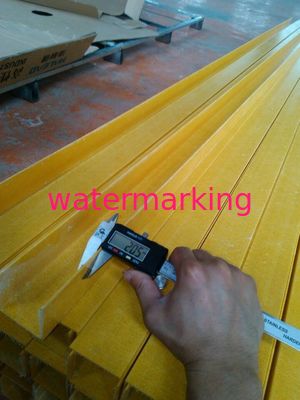-
Temperature Control Units (67)
-
Water Temperature Control Unit (43)
-
Oil Temperature Control Unit (70)
-
Mold Temperature Control Unit (43)
-
Hot Oil Temperature Control Units (29)
-
Air Cooled Screw Chiller (87)
-
Air Cooled Water Chiller (96)
-
Industrial Water Chiller (89)
-
Hot And Cold Unit (20)
-
FRP C Channel (7)
-
Mould Runner Cleaner (44)
-
FRP Square Tube (48)
-
FRP Round Tube (8)
-
FRP I Beams (4)
-
Pultruded FRP (10)
Fire / Heat Resistant Pultrusion FRP Channel FRP Composite Material
| Place of Origin: | Hubei, China |
| Brand Name: | Yulong |
| Certification: | ISO9001,ISO140001 |
| Model Number: | YLC-200*60*10 |
| Others:: | customized colors & dimension are both available. |
| Minimum Order Quantity: | 1*20ft |
| Price: | EXW, FOB, CNF, CIF |
| Packaging Details: | Plywood pallet with plastic wrapped for packing |
| Delivery Time: | About 5-10 days after deposit received |
| Payment Terms: | TT,L/C, Western Union, Money Gram |
| Supply Ability: | 16,000Tons/week |
| Port: | Yichang Port,China |
|
Detail Information |
|||
Product Description
Eco-friendly Fire & Heat Resistant Pultrusion FRP Channel Multi-Colors and Dimensions
Features:
- Non-Corrosive
- Lower Life Cycle Cost
- Easy to Fabricate and Install
- Lightweight/High Strength
- High Impact Strength
- Greater Flexural Strength Than Timber
- Dimensionally Stable
- Flame Retardant
- Electrically Non-Conductive
- Resists Insect Damage
- Low Water Absorption
- Non-Leeching
Pultrusion Technique:
Creels of unidirectional roving provide longitudinal tensile strength or the strength along the length of the profile. Rolls of continuous filament mat, woven roving, or stitched fabric provide the profile with its transverse properties or its strength across the width of the profile. All reinforcements are first fed through preforming guides that will begin to shape the raw glass fibers in to the finished profile. The glass is then pulled into a resin bath that saturates or “wets out” the reinforcements. The resin bath contains a mixture of resin, most commonly polyester or vinylester, pigments to add color, filler to enhance properties, and a catalyst to aid in curing or to turn it from a liquid to a solid.
Fiberglass reinforced plastic is one of the strongest and most durable materials in the world. Pultrusion is a manufacturing process for producing continuous lengths of fiberglass reinforced plastics shapes with a constant cross section. Surfacing veil is added to give the profile a resin rich surface and enhance the appearance of the final product. The wet out reinforcements now enter the heated pultrusion die. The heat begins the thermosetting reaction process that cures the finished profile. The cured profile is now advanced by a caterpillar style puller to the cut off saw where it will be cut to its final length.
![]()
Physical Property:
|
Product name: |
FRP/GRP Pultruded Channel |
|
Product dimension (Length x Width x thickness—mm) |
200*60*10 152*43*6.4 102*35*4.8 customized size is available. |
|
Raw Materials: |
|
|
Color: |
Grey, Blue, Yellow, Red, other customized colors |
|
Density: |
1.5-2.0 g/cm3 |
Application:
Architectural Concrete: cast stone, architectural cladding, balusters, column facades, window lentils, architectural precast elements, hand railing, and statuary and fountains, etc.
Concrete exposed to de-icing salts in: bridge decks, railroad grade crossings, median barriers, parking garage elements, and salt storage facilities, etc.
Concrete exposed to marine salts in: seawalls, water breaks, buildings & structures near waterfront, aquaculture operations, and floating marine docks, etc.
Applications Subjected to Other Corrosive Agents: Wastewater treatment plants; petrochemical plants; pulp/paper mills; liquid gas plants; pipelines / tanks for fossil fuel; cooling towers; chimneys; mining operations of various types; nuclear power and dump plants.
Applications Requiring Low Electric Conductivity or Electromagnetic Neutrality: Aluminum and copper smelting plants; manholes for electrical and telephone communication equipment; bases for transmission / telecommunication towers; airport control towers; magnetic resonance imaging in hospitals; railroad crossing sites, and specialized military structures.
Tunneling / Boring Applications Requiring Reinforcement of Temporary Concrete Structures: Structures including mining walls; underground rapid transit structures and underground vertical shafts.
Weight Sensitive Structures: Concrete construction in areas of poor load bearing soil conditions, remote geographical locations, sensitive environmental areas, or active seismic sites posing special issues that the use of lightweight reinforcement will solve.
Thermally Sensitive Applications: Apartment patio decks; thermally insulated concrete housing and basements; thermally heated floors and conditioning rooms.
Our other FRP composite products are pultrusion fiberglass square tube, frp channel, frp beams, frp round tube, frp flat bar, frp angle, frp cable tray, frp rod, frp rock bolt, frp rebar, frp mortar pipe and other frp profiles.
Contact us for more details.
![]()
![]()
![]()

